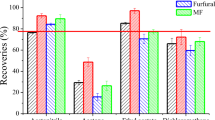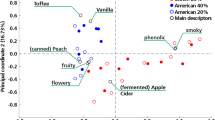Abstract
The food industry has a direct interest into bitter-tasting substances either for the identification of negative off-flavors or for the monitoring of a desired organoleptic quality. A rapid technique, based on Fourier transform-near infrared (FT-NIR) spectroscopy and able to detect taste molecular markers in bakery commodities, was developed, focusing the attention on biscuits category. Xanthines (caffeine, theobromine, and theophylline) and polyphenols (catechins and epicathechins), considered as mainly responsible for the bitter-taste of coffee\cocoa\chocolate based products, were firstly checked using a confirmatory liquid chromatography (LC)-ESI\mass spectrometry (MS)-MS procedure after hot methanol–water extraction. Correspondent data were used for the calibration of the FT-NIR through PLS regression. Values of the standard errors of prediction (lower than 10 %) were comparable to the values of the standard errors of cross-validation. Coefficients of determination indicated a good predictive power in the calibration model (R 2 xanthines = 0.97, R 2 polyphenols = 0.96) and a satisfying discriminating power among different contents in the validation models (R 2 xanthines = 0.96, R 2 polyphenols = 0.96). A testing phase on the generated model was executed by a comparison of LC-MS and sensory panel data with FT-NIR responses recorded on unknown biscuits: differences between found and predicted levels were generally below 5 % and the best predictability was achievable in chocolate-based biscuits. This methodology is able to work directly on solid products, has the potential to be expanded on other categories of gustative molecular markers (like sugars) and can be conceived as applicable for a routine control of a standardized bitter taste quality in a real industrial production.











Similar content being viewed by others
References
Bajec MR, Pickering GJ (2008) Astringency: Mechanisms and Perception. Crit Rev Food Sci Nutr 48:858
Banerji N, Bhosale R, Bollot G, Butterfield SM, Fürstenberg A, Gorteau V, Hagihara S, Hennig A, Maity S, Mareda J, Matile S, Mora F, Perez-Velasco A, Ravikumar V, Kishore RSK, Sakai N, Hien Tran D, Vauthey E (2008) Artificial tongues and leaves. Pure Appl. Chem B 80, R8, 1873
Baud-Camus F, Marquet P, Soursac M, Davrinche C, Farinotti R (2001) Determination of N-acetylation phenotype using caffeine as a metabolic probe and high-performance liquid chromatography with either ultraviolet detection or electrospray mass spectrometry. J Chromatogr B 760:55
Bjorsvik HR, Martens H (1992) Data Analysis: Calibration of NIR Instrument by PLS Regression. In: Handbook of Near Infrared Analysis Practical Spectroscopy Series 13. Marcel Dekker, Inc, New York, pp 159–180
Blanco M, Villaroya I (2002) NIR spectroscopy: a rapid-response analytical tool. Trends Anal Chem 21:240
Buchi AG (1993) Handbook of the NIR-spectrometer System. Uzwil, Switzerland
Chandrashekar J, Mueller KL, Hoon MA, Adler E, Feng L, Guo W, Zuker CS, Ryba NJP (2000) T2Rs function as bitter taste receptors. Cell 100:703
Chen Q, Zhao J, Liu M, Cai J, Liu J (2008) Determination of total polyphenols content in green tea using FT-NIR spectroscopy and different PLS algorithms. J Pharm Biomed Anal 46:568
Hall MN, Robertson A, Scotter CNG (1998) Near-infrared reflectance prediction of quality, theaflavin content and moisture content of black tea. Food Chem 27:61
He D, Shan Y, Wu Y, Liu G, Chen B, Yao S (2011) Simultaneous determination of flavanones, hydroxycinnamic acids and alkaloids in citrus fruits by HPLC-DAD–ESI/MS. Food Chem 127:880
Huck CW, Guggenbichler W, Bonn GK (2005) Analysis of caffeine, theobromine and theophylline in coffee by near infrared spectroscopy (NIRS) compared to high-performance liquid chromatography (HPLC) coupled to mass spectrometry. Anal Chim Acta 538:195
ISO (International Standard Organization) (1994) Determination of Individual Catechins and Total Polyphenols in Tea, ISO TC 34/SC 8 N 444
Ito M, Suzuki T, Yada S, Kusai A, Nakagami H, Yonemochi E, Terada K (2008) Development of a method for the determination of caffeine anhydrate in various designed intact tables by near-infrared spectroscopy: A comparison between reflectance and transmittance technique. J Pharm Biomed Anal 47:819
Lindemann B (1996) Tasting the sweet and the bitter, Current Biology B6, R 10, 1234
Lvova L, Martinelli E, Mazzone E, Pede A, Paolesse R, Di Natale C, D’Amico A (2006) Electronic tongue based on an array of metallic potentiometric sensors. Talanta 70:833
Neilson AJ (1988) Applied Sensory Analysis of Food. Vol. 1. In: Moskowitz H (ed). CRC Press, Inc., Boca Raton, FL, Chapter 2
Osborne G (1998) Near-infrared Spectroscopy in Food Analysis. Encyclopedia of Analytical Chemistry. http://www.wiley.com/legacy, 1-14
Pellicer A, Del Carmen Bravo M (2011) Near-infrared spectroscopy: A methodology-focused review. Semin Fetal Neonatal Med 16:42
Pigani L, Foca G, Ulrici A, Ionescu K, Martina V, Terzi F, Vignali M, Zanardi C, Seeber R (2009) Classification of red wines by chemometric analysis of voltammetric signals from PEDOTmodified electrodes. Anal Chim Acta 643:67
Rudnitskaya A, Polshin E, Kirsanov D, Lammertyn J, Nicolai B, Saison D, Delvaux FR, Delvaux F, Legin A (2009) Instrumental measurement of beer taste attributes using an electronic tongue. Anal Chim Acta 646:111
Rusconi M, Conti A (2010) Theobroma cacao L., the Food of the Gods: A scientific approach beyond myths and claims. Pharmacol Res 61:5
Sakai N, Mareda J, Matile S (2008) Artificial β-Barrels. Accounts Of Chemical Research B 41,R10, 1354
Scampicchio M, Ballabio D, Arecchi A, Cosio SM, Mannino S (2008) Amperometric electronic tongue for food analysis. Microchim Acta 163:11
Schinella G, Mosca S, Cienfuegos-Jovellanos E, Pasamar MÁ, Muguerza B, Ramon D, Rios JL (2010) Antioxidant properties of polyphenol-rich cocoa products industrially processed. Food Res Int 43:1614
Schneider H, Ma L, Glatt H (2003) Extractionless method for the determination of urinary caffeine metabolites using high-performance liquid chromatography coupled with tandem mass spectrometry. J Chromatogr B 789:227
Schulz H, Engelhardt UH, Wegent A, Drews H-H, Lapczynski S (1999) Application of Near-Infrared Reflectance Spectroscopy to the Simultaneous Prediction of Alkaloids and Phenolic Substances in Green Tea Leaves. J Agric Food Chem 47:5064
Shallenberger RS, Acree TE (1967) Molecular theory of sweet taste. Nature 216:480
Sinija VR, Mishra HN (2009) FT-NIR spectroscopy for caffeine estimation in instant green tea powder and granules. LWT – Food Sci Tech 42:998
Ternes T, Bonerz M, Schmidt T (2001) Determination of neutral pharmaceuticals in wastewater and rivers by liquid chromatography–electrospray tandem mass spectrometry. J Chrom 938:175
Tinti JM, Nofre C (1991) In sweeteners, discovery, molecular design and chemoreception. Am. Chem. Soc. Symposium Series. In: Walters DE, Orthoefer FT and DuBois GE (ed) Boston, USA 176
Umali AP, Anslyn EV (2010) A general approach to differential sensing using synthetic molecular receptors. Curr Opin Chem Biol 14:685
Vlasov YG, Legin AV, Rudnitskaya AM (2008) Electronic Tongue: Chemical Sensor Systems for Analysis of Aquatic Media. Russ J Gen Chem B 78(R12):2532
Williams PC (2001) Variables Affecting Near-Infrared Reflectance Spectroscopic Analysis. In: Williams P, Norris K (eds) Near-Infrared Technology in the Agricultural and Food Industries. American Association of Cereal Chemists, St Paul, pp 143–148
Winquist F, Bjorklund R, Krantz-Rulcker C, Lundström I, Östergren K, Skoglund T (2005) An electronic tongue in the dairy industry, Sensors and Actuators B 111-112, 299-304
Xu Y, Simon JE, Welch C, Wightman JD, Ferruzzi MG, Ho L, Passinetti GM, Wu Q (2011) Survey of Polyphenol Constituents in Grapes and Grape-Derived Products. J Agric Food Chem B 59(R19):10586–10593
Zhang D, Kuhr S, Engelhardt UH (1992) Influence of catechins and theaflavins on astringent taste of black tea brews. Eur Food Res Technol 195:108
Acknowledgments
The authors would like to thank Giovanni Campolongo (Büchi Labortechnik, Switzerland), Dante Catellani, and Gilda Re (Barilla SpA, Italy) for help and fruitful discussions.
Author information
Authors and Affiliations
Corresponding author
Rights and permissions
About this article
Cite this article
Bedini, A., Zanolli, V., Zanardi, S. et al. Rapid and Simultaneous Analysis of Xanthines and Polyphenols as Bitter Taste Markers in Bakery Products by FT-NIR Spectroscopy. Food Anal. Methods 6, 17–27 (2013). https://doi.org/10.1007/s12161-012-9405-7
Received:
Accepted:
Published:
Issue Date:
DOI: https://doi.org/10.1007/s12161-012-9405-7




